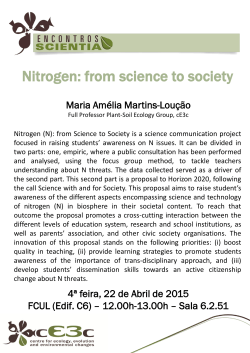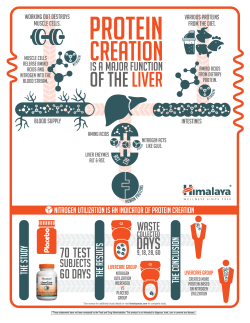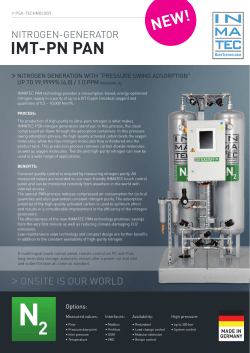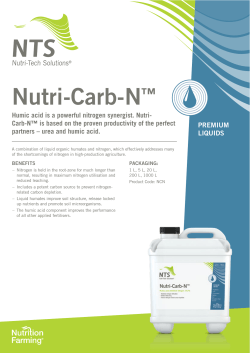
Lesson 4.12: Life Science â Nitrogen & Water Cycles
SCIENCE Lesson 4.12: Life Science – Nitrogen & Water Cycles Weekly Focus: Reading Comprehension Weekly Skill: Finding Evidence from Passage Lesson Summary: This week students will read two different passages on the nitrogen cycle. The first passage includes information about the water cycle while the second passage focuses on the nitrogen cycle. Students can also review the material from the reading passages by watching a short video clip, if time permits. Materials Needed: Comprehension Reading Unit 4.12 Handout 1 Comprehension Reading Unit 4.12 Handout 2 (Spectrum Science, Grade 6, pages 54-55) Video Unit 4.12 – The Nitrogen Cycle (2:46 min) Extra Work/Homework Unit 4.12 Handout 3 Objectives: Students will be able to… Read comprehension passages with vocabulary related to the nitrogen and water cycles Practice citing evidence from reading passages to answer comprehension questions College and Career Readiness Standards: RI, RST, WHST ACES Skills Addressed: EC, LS, ALS, CT, SM, N Notes: Please review and be familiar with classroom routine notes for: reading for fluency strategies (Routine 2), summarizing techniques (Routine 4), self-management skills (Routine 1). The notes for the different activities will help with making a smooth transition to each activity. GED 2014 Science Test Overview – For Teachers and Students The GED Science Test will be 90 minutes long and include approximately 34 questions with a total score value of 40. The questions will have focus on three content areas: life science (~40%), physical science (~40%), and Earth and space science (~20%). Students may be asked to read, analyze, understand, and extract information from a scientific reading, a news brief, a diagram, graph, table, or other material with scientific data and concepts or ideas. The online test may consist of multiple choice, drop down menu, and fill-in-the-blank questions. There will also be two short answer questions (suggested 10 minutes each) where students may have to design an experiment or identify errors in a conducted experiment, summarize, find evidence (supporting details), and reason or make a conclusion from the information (data) presented. The work students are doing in class will help them with the GED Science Test. They are also learning skills that will help in many other areas of their lives. H. Turngren, Minnesota Literacy Council, 2014 p.1 GED Science Curriculum SCIENCE Lesson 4.12: Life Science – Nitrogen & Water Cycles Activities: Warm-Up: KWL Chart Time: 10 - 15 minutes As students enter the class, have the following written on the board or overhead “The nitrogen cycle describes how nitrogen moves between plants, animals, bacteria, the atmosphere (the air), and soil in the ground.” Have students create a “KWL” chart on a piece of notebook paper (below). This helps to activate students’ prior knowledge by asking them what they already Know (column 1); students (collaborating as a classroom unit or within small groups) set goals specifying what they Want to learn (column 2); and after reading students discuss what they have Learned (column 3). Students apply higher-order thinking strategies which help them construct meaning from what they read and help them monitor their progress toward their goals. KWL Chart: K - What (else) do I KNOW? W - What do I WANT to know? L - What did I LEARN? . Activity 1: Comprehension Reading (Unit 4.12 Handout 1) Time: 40 - 45 minutes 1) Hand out Unit 4.12 Handout 1 to students. 2) Explain to students they will read about the nitrogen cycle. This information is important foundational knowledge for questions that may be on the 2014 GED Science module. 3) Discuss with students that when reading for comprehension, there are many strategies to use: read the title to predict what the reading is about; look at the subheadings to get a better idea of what each section is about; if there are images, look at them to gain understanding; while reading remember to ask “What is this all about?” 4) Have students read the passages independently while answering the questions at the end. 5) Circulate class while they are reading to make sure they understand the information presented and see if there are any questions. 6) Review answers as a whole class. Ask students to point to the evidence from the reading passage that helped them determine the answer(s). 7) If there is time, students can summarize the reading or write the main idea. 8) Students can fill in the “L” portion of the KWL chart. Break: 10 minutes Activity 2: Comprehension Reading (Unit 4.12 Handout 2) Time: 40 - 45 minutes 1) Hand out Unit 4.12 Handout 2 to students. 2) Explain to students they will continue learning about the nitrogen cycle by reading another passage. This information is important foundational knowledge for questions that may be on the 2014 GED Science module. H. Turngren, Minnesota Literacy Council, 2014 p.2 GED Science Curriculum SCIENCE Lesson 4.12: Life Science – Nitrogen & Water Cycles 3) Discuss with students that when reading for comprehension, there are many strategies to use: read the title to predict what the reading is about; look at the words in bold and their definitions on the left side of page; if there are images, look at them to get a better understanding; while reading remember to ask “What is this all about?” 4) Have students read the passages independently while answering the questions on each page. 5) Circulate class while they are reading to make sure they understand the information presented and see if there are any questions. 6) Review answers as a whole class. Ask students to point to the evidence from the reading passage that helped them determine the answer. 7) If there is time, students can create their own Venn diagram (from previous units) and look for what is similar and what is different from each of the reading passages with regards to the nitrogen cycle. This is an opportunity for students to practice what may be expected of them on the 2014 GED test. Wrap-Up: Summarize Time: 5 minutes Have students turn to a partner (or write in their journals) about what they have learned today about nitrogen and water cycles. Ask them to tell a partner one thing they learned today in one or two sentences. Note: Use Routine 4 Handout Extra Work/Homework: Unit 4.12 handout 3 Time: 30 - 45 minutes outside of class Students can continue to read about photosynthesis (unit 4.11) and its connection with Earth and Space science with a ReadWorks.org passage. This activity does a great job of bringing various science themes together in one reading passage. It is highly recommended for students to do outside of class. Differentiated Instruction/ELL Accommodation Suggestions If some students finish early, they can turn their paper over and summarize the reading passage. Teachers should be aware that ELLs could have some difficult time with some of the vocabulary encountered in the handouts for Activity 1 & 2. Encourage them to look for context clues in the reading that will help them with interpreting the main idea of each reading passage. H. Turngren, Minnesota Literacy Council, 2014 p.3 Activity Activity 1 and Activity 2 Activity 1 &2 GED Science Curriculum SCIENCE Lesson 4.12: Life Science – Nitrogen & Water Cycles Online Resources: If students have Internet connection, they can try an online interactive activity with the nitrogen cycle. It is from PBS Learning Media (click on “launch” to make it interactive). http://www.pbslearningmedia.org/resource/lsps07.sci.life.eco.nitrogen/the-nitrogen-cycle/ This is a link a slideshow presentation on the nitrogen cycle. There are plenty of images that may help with comprehension. http://www.picse.net/CD2011/nitrogen-cycle/index.html This is an interactive “game” about the nitrogen cycle. http://www.classzone.com/books/ml_science_share/vis_sim/em05_pg20_nitrogen/em05_pg20_nitrog en.swf Suggested Teacher Readings: GED Testing Service – GED Science Item Sample (to get an idea of what the test may be like) http://www.gedtestingservice.com/itemsamplerscience/ Assessment Guide for Educators: A guide to the 2014 assessment content from GED Testing Service: http://www.riaepdc.org/Documents/ALALBAASSESSMENT%20GUIDE%20CHAPTER%203.pdf Minnesota is getting ready for the 2014 GED test – the following is a website with updated information on the professional development in Minnesota regarding the 2014 GED. http://abe.mpls.k12.mn.us/ged_2014_2 Essential Education’s 2014 GED Test Curriculum Blueprint (PDF) http://www.passged.com/media/pdf/educators/curriculum-blueprint.pdf H. Turngren, Minnesota Literacy Council, 2014 p.4 GED Science Curriculum SCIENCE Lesson 4.12: Life Science – Nitrogen & Water Cycles Unit 4.12 handout 1 (4 pages total) H. Turngren, Minnesota Literacy Council, 2014 p.5 GED Science Curriculum SCIENCE Lesson 4.12: Life Science – Nitrogen & Water Cycles H. Turngren, Minnesota Literacy Council, 2014 p.6 GED Science Curriculum SCIENCE Lesson 4.12: Life Science – Nitrogen & Water Cycles H. Turngren, Minnesota Literacy Council, 2014 p.7 GED Science Curriculum SCIENCE Lesson 4.12: Life Science – Nitrogen & Water Cycles H. Turngren, Minnesota Literacy Council, 2014 p.8 GED Science Curriculum SCIENCE Lesson 4.12: Life Science – Nitrogen & Water Cycles TEACHER ANSWER KEY Unit 4.12 handout 1 1. nitrogen 3. fixation 2. decomposition. evaporation 4. condensation 5. precipitation. 6. 1 percent 7. pollution 8. Answer will vary. Suggested answer: Both substances are necessary for life, so they need to be recycled. 9. Answer will vary. Suggested answer: Evaporation changes water from a liquid to a gas; transpiration is the evaporation of water from a plant’s leaves. 10. Answer will vary. Suggested answer: The process is nitrogen fixation and it is made from lightning or the action of bacteria 11. Answer will vary. Suggested answer: It is scarce in some places and an increasing number of people on Earth means more water will be used, making it more scarce. 12. Answer will vary. Suggested answer: Transpiration from leaves no longer adds water vapor to the air. This means less water will condense and fall as precipitation. These areas may be drier. 13. C H. Turngren, Minnesota Literacy Council, 2014 p.9 GED Science Curriculum SCIENCE Lesson 4.12: Life Science – Nitrogen & Water Cycles 4.12 Handout 2 (3 pages total) H. Turngren, Minnesota Literacy Council, 2014 p.10 GED Science Curriculum SCIENCE Lesson 4.12: Life Science – Nitrogen & Water Cycles 4.12 Handout 2 TEACHER ANSWER KEY 1. true 2. false 3. true 4. false 5. false 6. true 7. The role of nitrogen fixing bacteria is to convert the nitrogen in the air and soil into a usable form 8. The two sources of free nitrogen in the soil are animal waste and decaying plant and animal matter 9. Too many nitrates in a body of water can be a problem because bacteria don’t have a chance to convert the nitrates back into nitrogen gas, which can make the water dangerous for people and animals. 10. Nitrates make their way into lakes and stream through rainwater and water used to irrigate crops 11. The sources of nitrogen for carnivores is by preying on herbivores Unifying Concepts and Processes: Answer may vary. Possible answer: The oxygen cycle; both happen continuously, and both are necessary for life on Earth Page 3: 1. amino acids 2. atmosphere 3. lightning 4. bacteria 5. animals 6. decomposition 7. leaching 8. legumes 9. nitrification 10. ammonia H. Turngren, Minnesota Literacy Council, 2014 p.11 GED Science Curriculum SCIENCE Lesson 4.12: Life Science – Nitrogen & Water Cycles 4.12 Handout 3 (4 pages total) ! ! Processes! Processes ! ! There’s!a!deep!and!complex!relationship!between!living!creatures,!inorganic!material! such!as!rock!and!minerals,!and!the!climate!conditions!we!experience,!such!as!rain!and!wind.! These!relationships!are!not!always!easy!to!see.!Sometimes,!the!relationship!operates!on!a! level!that!is!microscopically!small,!such!as!the!way!plants!transform!sunlight!into!nutrients.! Other!times,!the!relationship!can!be!observed!only!across!a!hugely!long!span!of!time— hundreds,!thousands,!or!even!millions!of!years.!But!the!connection!is!there,!and!we’re!in!a! unique!and!privileged!position!to!see!and!appreciate!it.! ! If!you!could!overcome!these!two!limitations!of!everyday!seeing—if!you!could!see!things! that!were!very!small!and!subtle,!and!if!you!could!see!things!that!occurred!over!a!very!long! stretch!of!time—what!would!you!see?!! ! It’s!a!matter!of!debate,!but!there’s!certainly!a!good!case!to!be!made!that!photosynthesis! may!be!the!most!exciting!earth!process!we!know!of.!We!know!that!plants!are!capable!of! converting!water,!carbon!dioxide,!and!sunlight!into!oxygen.!They!are!able!to!achieve!this! ® © 2013 ReadWorks , Inc. All rights reserved. H. Turngren, Minnesota Literacy Council, 2014 p.12 GED Science Curriculum SCIENCE Lesson 4.12: Life Science – Nitrogen & Water Cycles remarkable feat with a relatively small number of separate parts, and have done so, very reliably, for ages. Anyone who’s ever had a household plant, watered it, set it near light, watched it grow, and felt the air in her home to be cleaner has experienced this magic firsthand. But if you could see this process on a microscopically small scale, this abstract magic would be revealed as an extraordinary set of mechanisms. What if you could see photosynthesis working over the span of billions of years? This is the other remarkable thing: This mechanism, which operates on the smallest scale imaginable, has consequences that are literally global in scope, and span ages. If you could watch the earth evolve, you could see how, over two-and-a-half billion years ago, before the emergence of plants that could release oxygen, there simply wasn’t much of it at all in the atmosphere. Not much oxygen in the atmosphere meant there were nowhere near the number and variety of creatures we’ve come to know today. Over the course of hundreds of millions of years, you’d slowly begin seeing the emergence of tiny organisms capable of producing oxygen. However, you’d also notice that most of that oxygen was captured by minerals and other organic matter, never growing to very high levels in the atmosphere. Sooner or later, though, these organic and inorganic matter would reach their saturation point—the moment when they simply could not absorb any more oxygen. That’s when the oxygen created by organisms would become free oxygen. Free oxygen for everyone. Then, as an observer across the ages, you’d begin seeing the atmosphere change, from one dominated by methane and other elements, to one plentiful with oxygen. As we know, this is what set the stage for a huge diversity of mineral and organic life to emerge, including, many billions of years later, human beings. All of us, along with the foods we consume and the ground we walk on, are the direct descendants of a process that began billions of years ago, and that continues today, all across the planet, on a microscopically small level. What could be more exciting than that? Of course, if photosynthesis is the most exciting earth process we enjoy, then its energy from the opposite direction—heat from the Earth’s core—that’s the most mysterious. That’s because it originates, at least in part, from events that occurred at the very formation of the planet. Can you imagine such a thing as “pre-earth” space? It’s a pretty heavy concept. But imagine the part of the universe where the earth would soon be, but wasn’t yet. There, when the hot gases and particles were pulled together by gravity to create the early earth, immense heat was generated, and the resulting planetary core continues to cool to this day, radiating heat outward. The movement of more and less dense parts of the earth’s core produces heat. Most of all, there are massive amounts of radioactive material deep in the earth’s core, decaying slowly and releasing heat as they do. While energy from the sun sets in motion extraordinary interactions between the atmosphere, organisms and minerals, energy from the earth’s core profoundly affects the shape of the ground we walk on—literally. Again, imagine having the power to see very small and very slow. Processes that result from earth’s energy operate at these levels. We’re all familiar with the most visible results: earthquakes and volcanoes, which can be mighty indeed. But energy from the earth’s core is also responsible for the shift of tectonic plates, that is, the very placement of one continent relative to another, and, as a result, the emergence of mountains, chasms, oceans, and myriad more aspects of the environment. H. Turngren, Minnesota Literacy Council, 2014 p.13 GED Science Curriculum SCIENCE Lesson 4.12: Life Science – Nitrogen & Water Cycles This is what it really means to contemplate the origins of the planet and the universe. It’s not simply a matter of the far-away cosmos and their relationship to us. It’s the question of how it came to be that events occurring unimaginably long ago, and taking place at a rate so slow it’s impossible to see, have come to shape the ground we walk on. The decay of radioactive material deep in the earth’s core is responsible for not only the Rocky Mountains, but the formation of cities and societies that have lived there for generations, such as Rocky Mountain National Park, which serves as a beacon to the natural wonders of America and Canada. It’s responsible for mountains that serve as barriers, bringing to life divisions in culture unique to each side, while also posing a challenge to be crossed and burrowed into, spurring on scientific innovation in the process. So many aspects of what it means to be human, from the way cities are constructed, to the way nations are organized, are influenced by our natural environment, by the vast and complex set of processes that have shaped the earth since its inception, and will continue to do so long into the future. Answer the following questions from information in the reading passage. 1. Photosynthesis is an example of what? A. one of philosophy’s big ideas B. one of Earth’s key processes C. one of humankind’s best inventions D. one of science’s most well-known innovations 2. In this passage, the author provides a list of what? A. ways that the earth has been shaped by ancient natural processes B. ways that the earth has been shaped by scientific innovation C. ways that our lives have been shaped by philosopher’s theories D. ways that our lives have been shaped by cultural events 3. Photosynthesis is an important process that supports many kinds of life. What evidence from the text supports this conclusion? A. Photosynthesis may be the most exciting earth process we know of. B. Photosynthesis produces oxygen, which allowed diverse mineral and organic life to emerge. C. Photosynthesis operates on the smallest scale imaginable. D. Photosynthesis is a process by which plants convert water, carbon dioxide, and sunlight into oxygen. 4. What do processes on Earth have an impact on? A. living things only B. living things and the non-living environment C. the non-living environment only D. climate conditions only H. Turngren, Minnesota Literacy Council, 2014 p.14 GED Science Curriculum SCIENCE Lesson 4.12: Life Science – Nitrogen & Water Cycles 5. What is this passage mainly about? A. the history of the planets and moons within our solar system B. how the development of the earth has been impacted by its natural processes C. the early organisms that helped to populate the earth with oxygen D. the consequences that arise from the earth’s tectonic plate shifts 6. The author describes processes that involve changes happening on a small scale, and over billions of years. How does the author help the reader to understand those processes? A. The author includes graphs, charts, and a timeline. B. The author includes detailed illustrations to show these processes. C. The author describes what one would see as an “observer across the ages.” D. The author describes instructions for conducting one’s own experiments. 7. Choose the answer that best completes the sentence below. Energy from the sun sets in motion extraordinary interactions between the atmosphere, organisms and minerals. ___________, energy from the earth’s core profoundly affects the shape of the ground we walk on. A Consequently B Meanwhile C In conclusion D For example 8. Human beings need oxygen to breathe. Why is photosynthesis essential to the survival of human beings? _________________________________________________________________________________________________ _________________________________________________________________________________________________ _________________________________________________________________________________________________ _________________________________________________________________________________________________ 9. Explain how the earth’s core has impacted human life. Use evidence from the text to support your answer. _________________________________________________________________________________________________ _________________________________________________________________________________________________ _________________________________________________________________________________________________ _________________________________________________________________________________________________ 10. Could humans survive on Earth over two-and-a-half billion years ago, before the emergence of plants? Why or why not? Use evidence from the text to support your answer. _________________________________________________________________________________________________ _________________________________________________________________________________________________ _________________________________________________________________________________________________ _________________________________________________________________________________________________ H. Turngren, Minnesota Literacy Council, 2014 p.15 GED Science Curriculum SCIENCE Lesson 4.12: Life Science – Nitrogen & Water Cycles Unit 4.12 Handout 3 TEACHER ANSWER KEY 1. B 2. A 3. B 4. B 5. B 6. C 7. B 8. Answers may vary. Suggested answer: Photosynthesis produces oxygen, which humans need to breathe in order to survive. 9. Answers may vary. Suggested answer: Students should explain that the earth’s core affects the shape of the ground we walk on. Advanced answers may explain that this has implications on where people settle and how they form communities and societies. Students may also note that the decay of radioactive material deep in the earth’s core is responsible for not only the Rocky Mountains, but the formation of cities and societies that have lived there for generations, such as Rocky Mountain National Park. It’s responsible for mountains that serve as barriers, bringing to life divisions in culture unique to each side, while also posing a challenge to be crossed and burrowed into, spurring on scientific innovation in the process 10. Answers may vary. Suggested answer: No. Students should note that humans need oxygen to breathe, that photosynthesis creates oxygen, and that our atmosphere did not become full of oxygen until after plants evolved. H. Turngren, Minnesota Literacy Council, 2014 p.16 GED Science Curriculum
© Copyright 2025









